Since its discovery in 1886, the Witwatersrand Basin near Johannesburg, South Africa has produced more than 1.5 BILLION troy ounces of gold. That’s almost half of all the gold ever mined in the history of the world. Because of the basin’s vast gold bounty, African currency – the Rand – is named after it. But why exactly is there so much gold packed into that area?
The prevailing theory among geologists is that metallic gold eroded from the nearby Craton mountains. Over the course of millions of years, these alluvial gold deposits layered to form the veins of the Witwatersrand basin. However, Christoph Heinrich of the Swiss Federal Institute of Technology in Zurich, Switzerland has a different theory.
Three billion years ago, the earth’s atmosphere was mostly sulfuric gasses with very little oxygen. Published in Nature Geoscience, Heinrich postulates that the Craton mountain gold was chemically broken down by acid rain (prevalent in a sulfuric atmosphere) and then washed to the Witwatersrand basin as a liquid solution. Metallic gold was then extracted out of the solution by microbes to form the deposits we mine today. The earth’s current oxygen-rich atmosphere would break down the sulfur compounds that carry the gold, so this phenomenon can no longer be observed naturally.
Heinrich’s theory is certainly plausible. After all, chemistry has previously demonstrated that microbial life can convert gold-based chemical compounds into elemental form. If other gold deposits around the world formed the same way, then mining companies could use previously disregarded geological characteristics as clues for finding new deposits!











